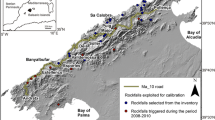Abstract
This paper presents a case study of an excavated rock slope to assess the coefficients of restitution using the results from field rockfall tests and corresponding rockfall simulations based on 3D photogrammetric slope surface models. The results from the field rockfall tests showed that rockfall trajectories were controlled by the orientations of joints at the initial point of the rockfalls. The lateral dispersion ratio (D H/L) of the trajectories was influenced by the shape index (γ) of falling rocks as well. The directions of rockfall trajectories, which were obtained from the 3D simulation based on the 3D photogrammetric surface models, were in agreement with the field rockfall tests. Throughout 2D analysis, which was performed using predefined trajectories from the 3D simulations, the coefficients of restitution were successfully calibrated using elapsed times and distances obtained from the field rockfall tests. Based on the accurate 3D photogrammetric slope model, the back-calculated coefficients of restitution from the 3D and 2D simulations combined with field rockfall tests provided consistent results between the numerical analyses and the field experimental data.












Similar content being viewed by others
References
Agliardi F, Crosta GB (2003) High resolution three-dimensional numerical modelling of rockfalls. Int J Rock Mech Min Sci 40:455–471
Andrew R et al (2012) CRSP-3D user’s manual Colorado rockfall simulation program. Technical report, FHWA-CFL/TD-12-007
Arikan F, Ulusay R, Aydin N (2007) Characterization of weathered acidic volcanic rocks and a weathering classification based on a rating system. Bull Eng Geol Environ 66:415–430
Asteriou P, Saroglou H, Tsiambaos G (2012) Geotechnical and kinematic parameters affecting the coefficients of restitution for rock fall analysis. Int J Rock Mech Min Sci 54:103–113
Azzoni A, de Freitas MH (1995) Experimentally gained parameters, decisive for rock fall analysis. Rock Mech Rock Eng 28(2):111–124
Azzoni A, La Barbera G, Zaninetti A (1995) Analysis and prediction of rockfalls using a mathematical model. Int J Rock Mech Min Sci Geomech Abstr 32:709–724
Barton N, Choubey V (1977) The shear strength of rock joints in theory and practice. Rock Mech 10:1–54
Basson FRP (2012) Rigid body dynamics for rock fall trajectory simulation. The 46th US Rock Mechanics/Geomechanics Symposium, ARMA 12-267
Buzzi O, Giacomini A, Spadari M (2012) Laboratory investigation on high values of restitution coefficients. Rock Mech Rock Eng 45(1):35–43
Cai M, Kaiser PK, Uno H, Tasaka Y, Minami M (2004) Estimation of rock mass deformation modulus and strength of jointed hard rock masses using the GSI system. Int J Rock Mech Min Sci 41:3–19
Chau KT, Wong RHC, Wu JJ (2002) Coefficient of restitution and rotation motions of rockfall impacts. Int J Rock Mech Min Sci 39:69–77
Christen M, Kowalski J, Bartelt D (2010) RAMMS: numerical simulation of dense snow avalanches in three-dimensional terrain. Cold Reg Sci Technol 63:1–14
Commonwealth Scientific and Industrial Research Organisation (2005) Field procedures for photogrammetric pit mapping. CSIRO Exploration & Mining
Dorren LKA, Berger F, Putters US (2006) Real-size experiments and 3-D simulation of rockfall on forested and non-forested slopes. Nat Hazards Earth Syst Sci 6:145–153
Giacomini A, Thoeni K, Lambert C (2012) Improved management of the rock fall hazard at the base of the highwalls. ACARP project report C19026
Giovanni G, Stefano M, Simone F, Nicola C (2014) Terrestrial laser scanner and geomechanical surveys for the rapid evaluation of rock fall susceptibility scenarios. Landslides 11:1–14. doi:10.1007/s10346-012-0374-0
Graf CC, Peryoga T, McCartney G, Rees T (2013) Verification of Trajec3D for use in rockfall analysis at Newmont Boddington Gold. In: Proceedings of the 2013 international Symposium on slope stability in open pit mining and civil engineering, Brisbane: 1231–1241
Guzzetti F, Crosta G, Detti R, Agliardi F (2002) STONE: a computer program for the three-dimensional simulation of rock-falls. Comput Geosci 28:1079–1093
Haramy KY, Zhang R, Rock A (2013) CRSP-3D application for remediating a rockfall at Yosemite national park. In: Proceedings of the Geo-Congress, ASCE, stability and performance of slopes and Embankments III, San Diego, California, pp 592–603
Katz O, Reches Z, Roegiers J-C (2000) Evaluation of mechanical rock properties using a Schmidt hammer. Int J Rock Mech Min Sci 37:723–728
Leine RI, Schweize A, Christen M, Glover J, Bartelt P, Gerber W (2013) Simulation of rockfall trajectories with consideration of rock shape. Multibody Syst Dyn. doi:10.1007/s11044-013-9393-4
Peng B (2000) Rockfall trajectory analysis: parameter determination and application. Thesis of Master of Science in Engineering Geology in the University of Canterbury
Pfeiffer TJ (1989) Rockfall hazard analysis using computer simulation of rockfalls. Engineering Report, Colorado school of Mines, ER-3614
Rocscience Inc. (2003) RocFall version 4.0; statistical analysis of rockfalls, www.rocscience.com, Toronto, Ontario, Canada
Stevens W (1998) RocFall: a tool for probabilistic analysis, design of remedial measures and prediction of rockfalls. M.A.Sc Thesis, Department of Civil Engineering, University of Toronto, Ontario, Canada
Tse R, Cruden DM (1979) Estimating joint roughness coefficients. Int J Rock Mech Min Sci 16:303–307
Wang LG, Yamashita S, Sugimoto F, Pan C, Tan G (2003) A methodology for predicting the in situ size and shape distribution of rock blocks. Rock Mech Rock Eng 36(2):121–142
Willmott W (2010) Rocks and landscape of the Gold Coast hinterland. Geological society of Australia, Queensland division
Acknowledgments
The authors would like to express their appreciation to Mr. George Poropat from CSIRO and Dr. Hongyu Qin in Griffith University for the valuable help with this research. In addition, the authors appreciate Concrib Pty Ltd for the support to perform the site experiments.
Author information
Authors and Affiliations
Corresponding author
Rights and permissions
About this article
Cite this article
Kim, D.H., Gratchev, I., Berends, J. et al. Calibration of restitution coefficients using rockfall simulations based on 3D photogrammetry model: a case study. Nat Hazards 78, 1931–1946 (2015). https://doi.org/10.1007/s11069-015-1811-x
Received:
Accepted:
Published:
Issue Date:
DOI: https://doi.org/10.1007/s11069-015-1811-x



